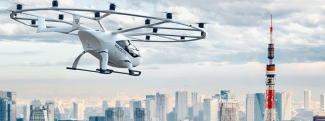ALG was engaged by Neom to provide an independent assessment of the eVTOL start-up Volocopter, which is developing innovative solutions for air mobility in urban and interurban environments.
eVTOLs are electric vertical take-off and landing vehicles. The civilian applications of these vehicles mostly relate to urban mobility, with uses such as air-taxi services to avoid highly congested roads, delivery of goods using UAVs (unmanned air vehicles) and rapid medical assistance in environments where land transport does not provide satisfactory response times.
eVTOLs solutions can mainly be categorised into three groups:
- Wingless
● Multirotors, enabling a large disk actuator surface
● Efficient at hovering but less efficient in cruise mode
● Limited cruise speed (~100 km/h)
● Shorter flight ranges (~40km) and times (~30 min) - Lift + Cruise
● Winged, like vectored thrust eVTOLs, but use two different propulsion systems for hover and cruise
● Efficient at cruising
● Higher cruise speed (>150 km/h)
● Longer flight ranges (>100km) and times (~40 min) - Vectored thrust
● Winged, using the same propulsion system for both hover and cruise
● Efficient at cruising
● Highest cruise speed (>200 km/h)
● Longest flight ranges (>200km) and times (~50 min)
Volocopter is starting by focusing on developing its Volocity product. This is a two-seater vehicle with a wingless design focused exclusively on short journeys inside cities. It will subsequently be complemented by other products for interurban mobility, drone deliveries and systems solutions to integrate the various products and services.
Objectives, goals and purposes
The objectives of this project were to explore Volocopter’s certification progress, the company’s technological development and public acceptance of the proposed solutions being incorporated into the mobility ecosystem.
ALG was supported in this assignment by Airmap, which develops airspace management software systems for drones and had previous experience with Volocopter and its team.
Study methodology and activities
The scope of the study was divided into three main tasks, in line with the objectives agreed with the client.
The following tasks were conducted in relation to the certification process:
- Review of the certification path set by EASA, in particular SC-VTOL-01, focusing on the Enhanced category, as this corresponds to intracity commercial air transport
- Identification of the main certification milestones (R&D certification for manned testing, Design Organisation Approval, etc.)
- Review of the test-flight plan, tested items and results of the tests
- Identification of the regulatory challenges for the technology solution adopted by Volocopter (wingless design)
The following tasks were conducted in relation to technological development:
- Review of the characteristics of the available eVTOL technologies
- Detailing of the technical solutions proposed by Volocopter:
● Motor selection
● Availability of redundancies for safe operation
● Design speed
● Safety measures: mechanisms for collision avoidance and bird strike damage
● Range limitations
● Battery efficiency and technology assessment
● Maintenance procedures
Finally, the aspects believed to be most relevant for public acceptance of the technology were assessed:
- The noise footprint of the vehicles in comparison with other urban noise generators
- User experience
● Embarking and disembarking process
● Luggage capacity
● Cabin conditions: comfort, noise, vibrations, temperature, visibility, etc. - Key findings and recommendations
- Volocopter’s eVTOLs are designed to comply with EASA's specific airworthiness requirements for intracity commercial air transport
- Certification of Volocopter in Europe would be an initial enabler for operations in Saudi Arabia
- Volocopter has demonstrated operational experience of test flights in several cities in different continents (Stuttgart, Helsinki, Dubai and Singapore) and has built sample ground infrastructure (vertiports)
- Volocopter’s technology enables 30-35 km flight operations with an energy-efficient system design and simplified maintenance requirements
- Extended flight ranges are expected in the next decade with development of battery technology
- Volocopter’s plan to develop a four-seater aircraft with a longer range (70-90 km) to be launched further in the future is expected to succeed given the rapid development of battery technology
- Volocopter’s differentiating factors are low noise emissions and its design for usability
- Volocopter’s strategy is to become a provider of mobility services, focusing on developing multi-modal transport networks integrated with eVTOL operations
Success and outcomes
In December 2021, Neom announced a joint venture with Volocopter for the operation of electric air-taxi services in Neom to connect various regions, including The Line, Oxagon and Trojena.
Building on that agreement, on 2 November 2022 Neom announced Series E investment in Volocopter amounting to USD 175 million, representing a significant equity stake in the company as part of its strategic engagement with the global eVTOL industry.

